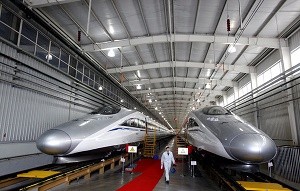China is now among the leading countries in high-speed railway technology after it announced the development of a cutting-edge permanent magnet synchronous traction system that will enable bullet trains to travel at an ultrafast 500 kilometers per hour.
The China Daily reported that CRRC Corp., the country's train-making giant, has developed the advanced 690-kilowatt traction system at its Zhuzhou Institute in Hunan Province.
Ding Rongjun, a member of the Chinese Academy of Engineering who heads the institute, said that the new traction system will soon enter mass production. He added that only a few countries can manufacture the sophisticated apparatus, including Germany and Japan.
"Now we have our own permanent magnet synchronous traction system with full intellectual property rights, marking a new chapter in China's high-speed railways," Ding said.
Feng Jianghua, deputy director of the Zhuzhou Institute, said that the traction equipment is the most important part of a bullet train and the adoption of the technology is expected to reform the high-speed railway industry.
Most high-speed trains currently used in the world are propelled by alternating current asynchronous motors, a traction system that was first developed during the 1970s.
Feng told China Economic Weekly that the Zhuzhou Institute began research and development on permanent magnet synchronous traction technology in 2003 after major international trainmakers, like Siemens and Bombardier, launched projects and showed their intention to acquire the equipment.
Xu Junfeng, a senior engineer at the institute, was also quoted in the magazine, as China had never noticed the high-tech equipment before the project and that engineers had to overcome several technical difficulties.
Xu said that the engineers completed development in 2011, after eight years, and tried the advanced traction system on trains on Subway Line 2 in Shenyang, Liaoning Province. The tests proved successful.
The report said that the institute applied the system to bullet trains, expecting speeds of 500 km/h in Dec. 2013, and the trials were undertaken on several trains in October.
Jia Limin of Beijing Jiaotong University, who heads China's high-speed railway innovation program, said that the trains equipped with the new traction system will become fully operational by 2018.
Jia said that the new system has simpler configuration, more power, and lower electrical consumption, compared with an alternating current asynchronous motor.
Sheng Guangzu, general manager of China Railway Corp., has vowed to speed up the development of key technologies in high-speed rail and to design a new bullet train based on Chinese standards.



























